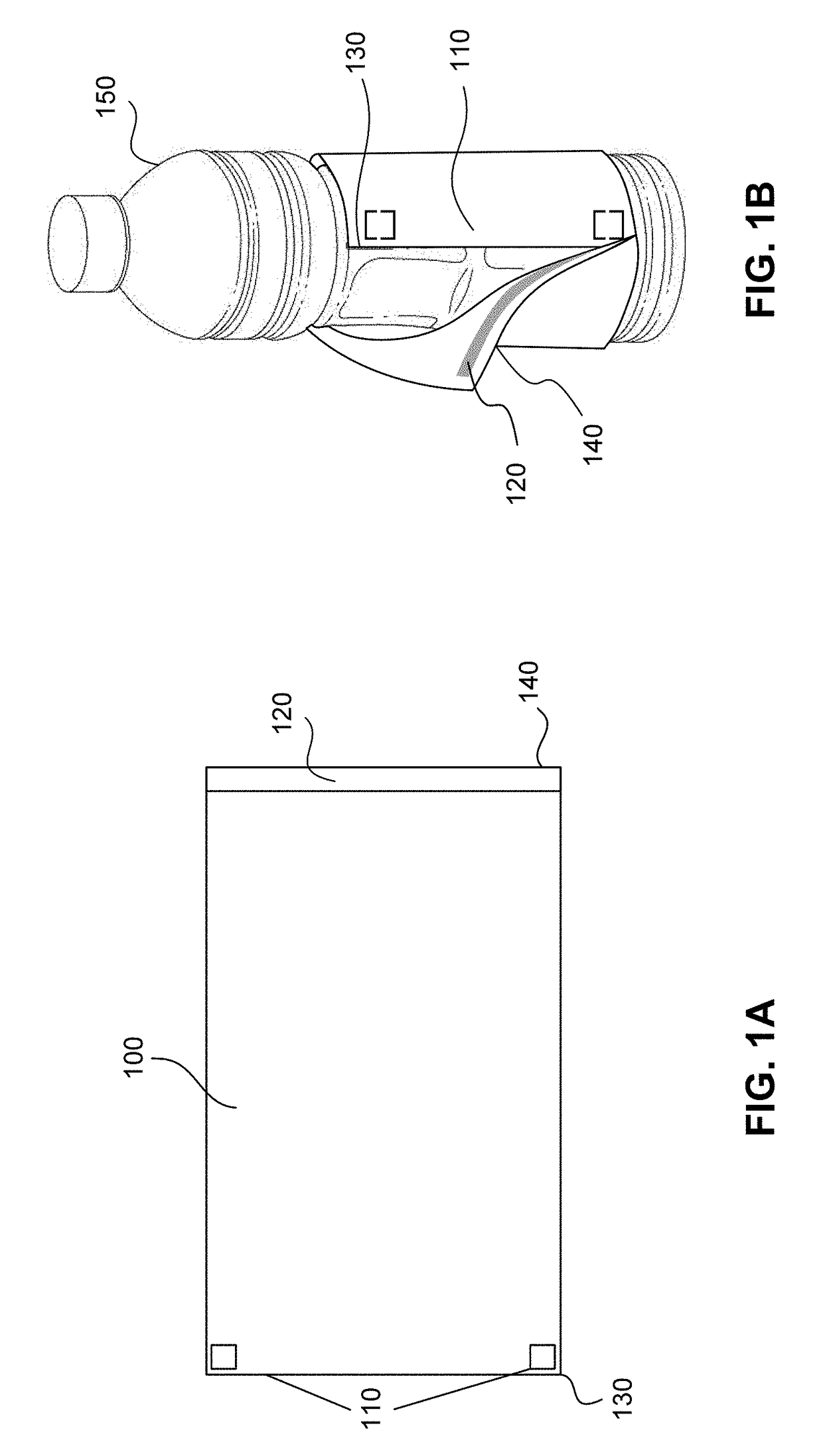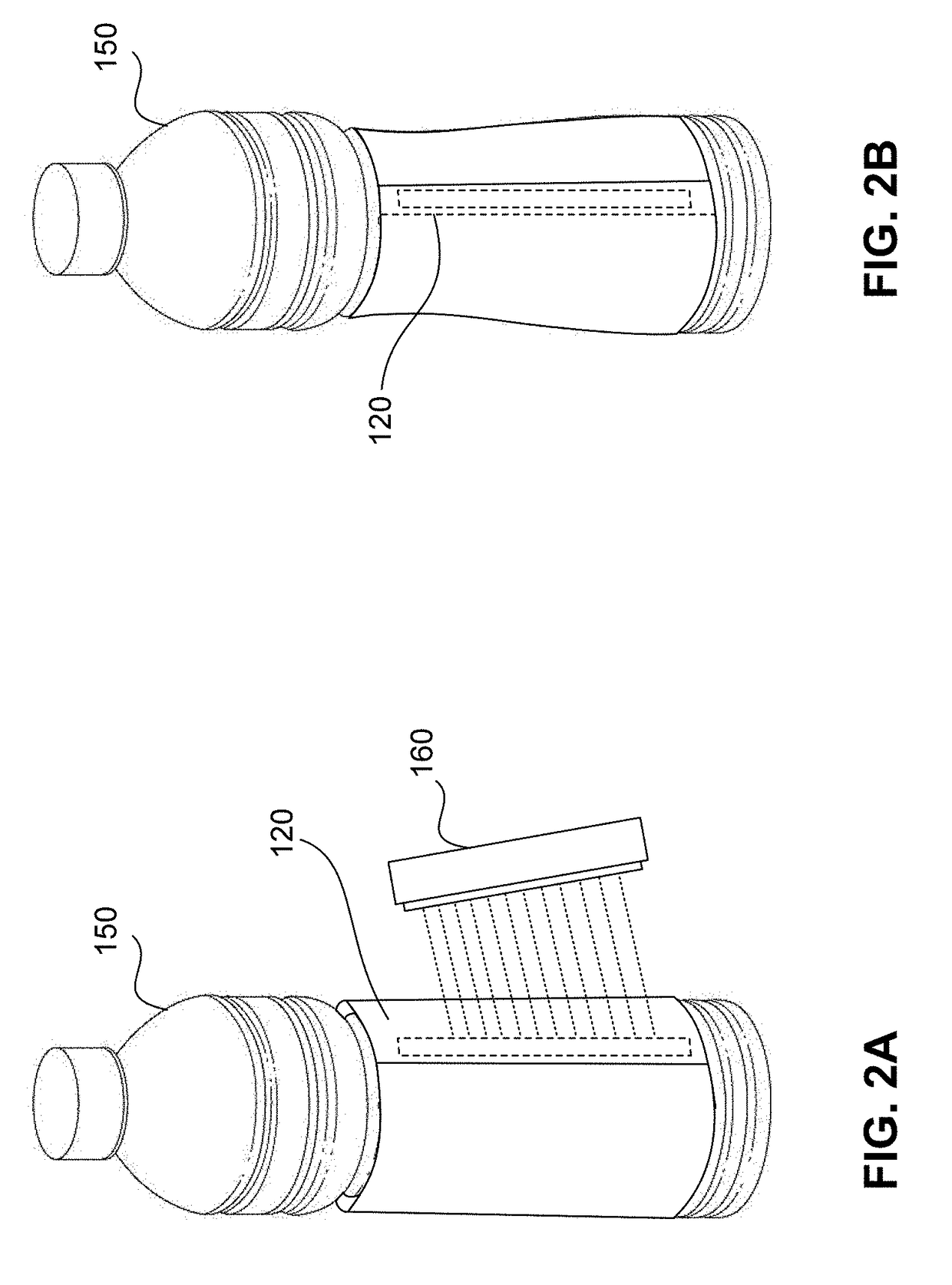Fixing wrap-around labels with led-curable adhesives
a technology of adhesives and wrap-around labels, applied in the field of labeling an article with a film label, can solve the problem that the edge adhesive is not led curabl
- Summary
- Abstract
- Description
- Claims
- Application Information
AI Technical Summary
Benefits of technology
Problems solved by technology
Method used
Image
Examples
example 1
[0094]A control test was run using a hot-melt adhesive. The hot-melt adhesive was used for both the leading edge and trailing edge adhesive. A heater was used to raise the temperature of the adhesive to 290° F., no LED lamps were used in the control experiments. After heating, the adhesive was cooled to bond the leading edge and trailing edge of the label.
Peel Shear No. ofWrappingBondBondLEDType ofRunSpeedStrength Strength RunLampsLabelTemperature(bpm)(lb)(lb)10Metallized290° F.600 bpm4.3320(143° C.)20Clear290° F.600 bpm5.3719.99(143° C.)30White290° F.400 bpm4.5519.75(143° C.)
example 2
[0095]The opacity of clear, white, and metallized labels were tested on the front surface of the labels, in an area without any markings or printing, using A2 illuminant and 2° observer angle using the entire spectrum from 400 nm to 700 nm. For each type of label, the opacity of 10 different samples was measured. The clear, white, and metallized labels had an average opacity of 17.6%, 83 and 100%, respectively.
[0096]The transmission of regular intensity light through clear, white, and metallized labels was measured at 395 nm using a UV-Vis spectrophotometer. Light transmission through the clear, white, and metallized labels was 86%, 0.3%, and 0%, respectively. Test results, for example those discussed in Examples 3-5, indicate that significantly higher transmission rates can be achieved with white and metallized labels if a high intensity monochromatic LED light source is used to cure the adhesives. For example, LED lamps having a peak irradiance of 20 W / ...
example 3
le Adhesive Sample A
[0097]LED-curable adhesive Sample A was used for both the leading edge adhesive (pickup adhesive) and the trailing edge adhesive (lap adhesive). The table below shows the results of various process configurations for wrapping bottles using LED-curable adhesive Sample A. To test the peel bond strength and shear bond strength of adhesive Sample A, various modifications were made to the process parameters. Variables modified throughout the runs included number of LED lamps used to cure the adhesive, label type, temperature, lamp position, and wrapping speed. For each run listed in the table below, both the leading edge adhesive and the trailing edge adhesive cured. A heater was used to raise the temperature to the temperature indicated in the table below.
[0098]In the non-modified lamp position, one or more LED lamps were located at the LED station, described above. Runs 5, 6, 9, 10, and 13-20 were run with the LED lamps in the modified setup as described above. The ...
PUM
| Property | Measurement | Unit |
|---|---|---|
| Temperature | aaaaa | aaaaa |
| Temperature | aaaaa | aaaaa |
| Fraction | aaaaa | aaaaa |
Abstract
Description
Claims
Application Information
 Login to View More
Login to View More - R&D
- Intellectual Property
- Life Sciences
- Materials
- Tech Scout
- Unparalleled Data Quality
- Higher Quality Content
- 60% Fewer Hallucinations
Browse by: Latest US Patents, China's latest patents, Technical Efficacy Thesaurus, Application Domain, Technology Topic, Popular Technical Reports.
© 2025 PatSnap. All rights reserved.Legal|Privacy policy|Modern Slavery Act Transparency Statement|Sitemap|About US| Contact US: help@patsnap.com



